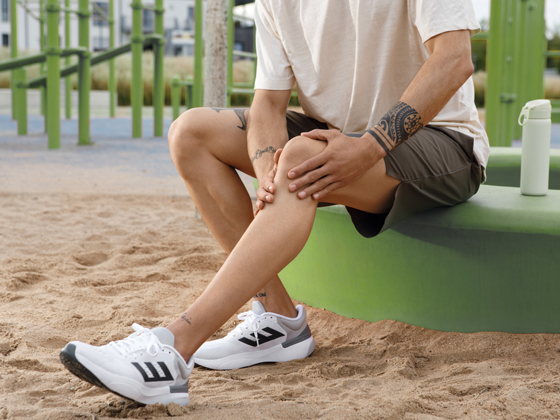When should you wear a knee support?
Medical knee supports can be a valuable tool for knee pain, orthopaedic knee problems, heavy strain or after knee injuries and surgery. Supports are an ideal tool for returning to activity.

Support your knee joint in case of sprains or strains, after surgery or for misalignments! Our knee supports stabilise your knee joint and reduce the risk of injury. At Juzo, they are made from breathable, skin-friendly materials. The optimised compression knit ensures a perfect fit and amble freedom of movement. Whether for everyday life, sports or work – you can find the ideal support for every knee problem here.
Patellar tendon strap
Art. 1813
Knee support with special stretch zone
Art. 1810
Knee support with patella ring
Art. 3212, 3212-Comfort
Knee support with crescent-shaped, asymmetric pads
Art. 3242
Knee support with bilateral joint splints
Art. 1402
Knee support with movement-friendly middle knee section
Art. 3022
Knee support with bilateral double spiral stays
Art. 3222
Knee support with movement-friendly knee joint zone
Art. 3062
Knee support with special knit fabric in the hollow of the knee
Art. 3262
The knee joint is the largest and most powerful joint in the human body. It connects the thigh bone (femur), shinbone (tibia) and kneecap (patella). A complex arrangement of ligaments and cartilage ensure smooth joint function. Disruptions to the interplay of the individual components can trigger knee pain. This may be caused by excessive or undue strain, illness and injuries.
Our knee joints are subjected to a great deal of strain every day. Whether when walking, bending over, climbing stairs or doing exercise – intact knees are essential for smooth movement. For knee problems, pain or heavy strain, an orthopaedic knee support can provide valuable assistance. Your physician can decide whether a support is beneficial. In general, the rule is that medical knee supports are suitable for everyday use by anyone with sensitive or damaged knee joints who spends a lot of time on their feet. This protects the joint against excessive strain.

Note: Choose the right knee support depending on your symptoms and condition.
The functional compression knit fabric surrounds the affected, injured, operated or strained knee and exerts uniform compression. This improves proprioception, compensates for muscular imbalances and stabilises the joint.
Our knee support models with patella ring or integrated silicone pads deliver uniform pressure distribution, as well as more grip for the kneecap. Our knee supports provide lateral hold with joint splints or spiral stays on both sides. For enhanced wearing comfort, you can find models with special knee zones. Juzo Xtra supports are technically sophisticated medical aids that adapt flexibly to movement patterns. The stabilisation elements and breathable knitted fabrics are based on the human anatomy and natural movement sequences. Special stretch zones and reduced pressure at the borders ensure ideal wearing comfort during movement.
When should you wear a knee support?
Medical knee supports can be a valuable tool for knee pain, orthopaedic knee problems, heavy strain or after knee injuries and surgery. Supports are an ideal tool for returning to activity.
How long should you wear a knee support?
How many hours per day should you wear a knee support?
The daily wearing time is also recommended by the physician or therapist. In principle, there is no maximum wearing time for a properly fitted knee support.
Is a support helpful for knee pain?
For many conditions that affect the knee joint, it is effective and recommended to use a support. Ask your physician or therapist if this is right for you.
What is the difference between a knee support and a knee orthosis?
Knee supports offer lots of flexibility. The compression effect can help to reduce swelling and promote the healing process. They relieve the knee joint and can also help to reduce muscular imbalances. Supports are frequently used for returning to activity. Knee orthoses, on the other hand, are primarily used after acute injuries or surgery. With their generally rigid design, they restrict the range of motion and provide stable protection. They are used for example for temporary immobilisation, controlled stabilisation and anatomical guidance of the knee.